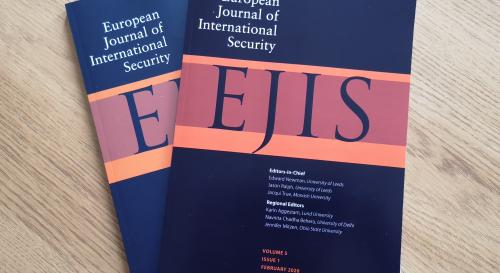
Breadcrumbs navigation
Citizen-centred or state-centred? The representational design of International Parliamentary Institutions
Jofre Rocabert and Thomas Winzen discuss their new article published in BISA journal Review of International Studies. The article discusses crucial questions of representational design faced by international organisations as a result of the spread of International Parliamentary Institutions (IPIs).
International organizations (IOs) are the realm of executives. They mandate their objectives, control their accomplishment, and in most cases are the only branch of government represented in their decision-making bodies. However, some IOs also have international parliamentary institutions (IPIs). IPIs are remarkable because they break the near-monopoly that executives hold representing the state, and bring parliamentarians directly into the institutional designs of IOs. One case is well-known, the European Parliament. Others are familiar to readers of international politics, such as the OSCE Parliamentary Assembly or the Nordic Council. And yet others are less known, such as the Southern African Development Community (SADC) Parliamentary Forum.
Although the first IPIs appeared in parallel to IOs in the international system, most of them were created between the late 70s and late 90s. Regional integration projects throughout Europe, Africa, and Latin America adopted this strategy widely, regardless of their democratic or autocratic membership. The creation of international parliaments was an institutional innovation for many IOs that aspired to forge a sense of community amongst its members. Their existence creates a link between the symbolism and centrality that parliaments have in democratic politics and the institutional structure of international organizations.
Even if these international parliaments are unlike national chambers in some respects, we highlight in our study that they face many similar design choices. These choices include how members are selected, the distribution of votes amongst members and the logic of parliamentary groupings. We explore the design of IPIs around the world based on these three dimensions. First, in the great majority of IPIs, members are selected from national parliaments of IO member states. However, the European Parliament and part of three Latin American IPIs are (partly) elected directly, and some other institutions have the stated goal to transition towards direct elections. Second, there is significant variation in whether IPI rules establish that all countries have the same number of representatives or introduce some degree of proportionality with member state populations. Finally, legislative factions often follow national lines, but may also group representatives from several member states according to their political leaning.
We distinguish two ideal-typical representational designs. One type of IPI may be directly elected, with population-adjusted membership, and grouped according to political lines. The other type is indirectly elected (members elected by their national parliaments), all delegations have the same members, and its factions are organized along territorial lines. We name these two ideal types citizen-centered and state-centered IPIs respectively. The first resembles the make-up of many lower chambers in national parliaments, and thus potentially bring into the IO the same kind of issue-linkage and deterritorialized representation of interests. The second type reproduces the logic of state representation in IOs, or territorial-based representation typical of upper chambers in many parliaments.
In practice, the design of IPIs can of course vary. About half of all IPIs have at least one citizen-centered trait. The most common is proportional representation, while parliamentary groups according to political lines are present in only seven IPIs, and only four elect their members directly, only the European Parliament elects all of its members. We might ask ourselves then, which factors are common to the IOs that design their parliamentary bodies with citizen-centered features, rather than simply reproduce state-based representation.
Our study explores the association between citizen-centered designs in IPIs and three different IO characteristics. First, the institutional purpose of IO. We use the distinction between general-purpose and task-specific IOs proposed by Liesbet Hooghe. General-purpose IOs have regional-building objectives, and although there is a strong correlation between this characteristic and having IPIs in the first place, not all IPIs belong to general-purpose IPIs. The OSCE Parliamentary Assembly, for instance, belongs to an IO that is specifically dedicated to security and stabilization. We also look at the homogeneity of IO membership using measures of the variance of their GDP and populations, and finally, we measure the democratic levels of their members through both Polity IV and V-Dem indices.
Our results suggest that only regional-building objectives and democratic membership are associated with choosing citizen-centered designs for international parliamentary institutions. This result stands when the European Union and the Council of Europe are excluded from the sample. These findings indicate that IPIs, while increasingly common, might not constitute as new a representational mechanism in IOs as might seem at first. While they do bring new actors into an IO, they otherwise mostly follow the state-based representational design that we also find in the IO bodies of national governments.
Although it is true that IPIs have emerged and gained their citizen-centered designs over time, we also argue that this trend is not likely to continue. IPIs have a very slow institutional change, and the youngest IPI was created more than ten years ago. Of the six IOs we have identified as favorable to the existence of citizen-centered designs (being both general-purpose and democratic), four already have two or more citizen-centered designs. Only the parliaments of the Organization of Eastern Caribbean States and the Andean Community seem likely cases for more citizen-centered designs. Overall, representational design in IOs might remain mainly state-centered for the foreseeable future despite the rise of IPIs.
You can read the full article at DOI: https://doi.org/10.1017/S0260210520000327
BISA members receive access to RIS (and to our other journal European Journal of International Security) as a benefit of membership. To gain access, log in to your BISA account and scroll down to the 'Membership benefits' section. If you're not yet a member join today.
Photo by Guillaume Périgois on Unsplash


